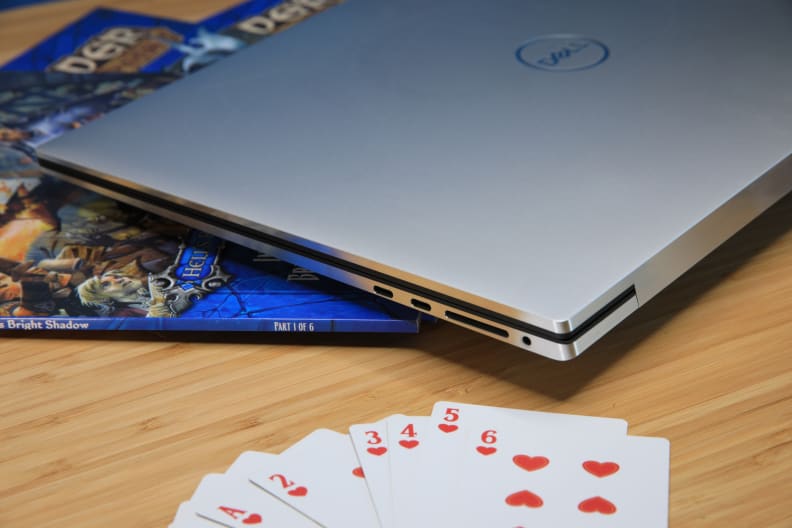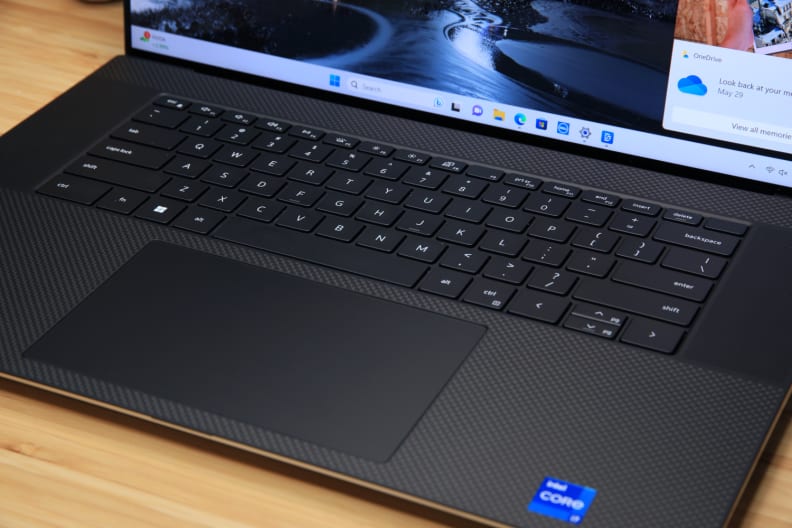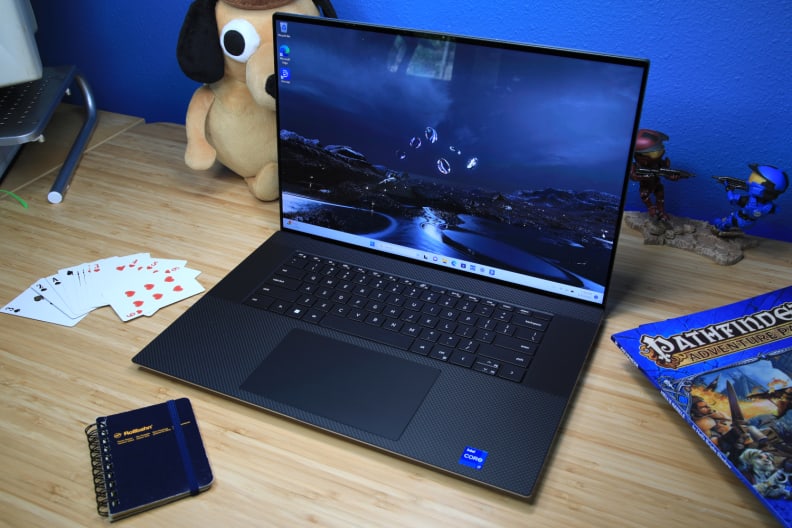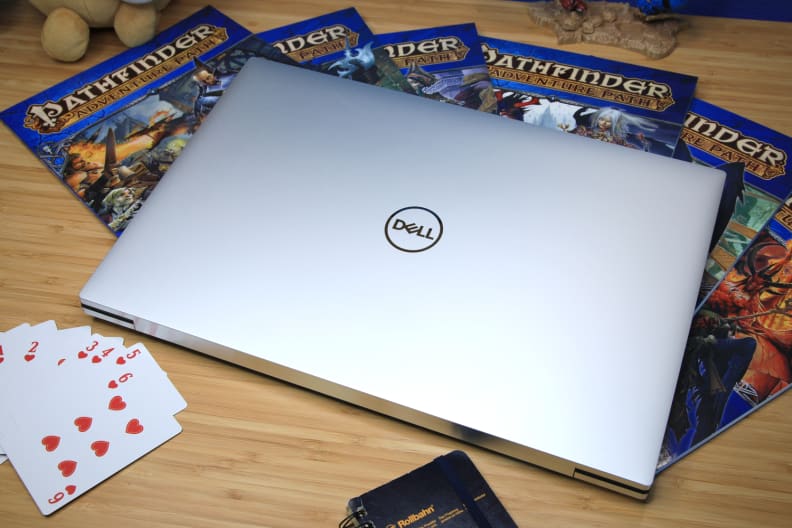For a large yet slim laptop, Dell’s XPS 17 provides an incredible amount of versatility.
About the Dell XPS 17
Here are the specs of the laptop we tested:
- Price as configured: $2,949 (discounted) $3,349 (estimated value)
- Processor: Intel Core i7-13700H
- Graphics: Nvidia RTX 4070, Intel Iris Xe graphics
- RAM: 32GB LPDDR5
- Storage: 1TB NVMe PCIe SSD
- Display: 17-inch, 3840 x 2400, 60Hz IPS touchscreen
- Wireless connectivity: Wi-Fi 6E, Bluetooth 5.3
- Ports: 4x Thunderbolt 4 / USB-C with DisplayPort and USB Power Delivery, 1x SD card, 1x 3.5mm audio jack
- Weight: 5.37 pounds
- Dimensions: 14.74 x 9.76 x 0.77 inches
- Warranty: 1-year limited laptop warranty
The Dell XPS 17 I tested is a mid-range configuration with a base Intel Core i7-13700H processor (upgradeable to a Core i9-13900H), while Nvidia’s RTX 4070 is an upgrade from the base RTX 4050. The RTX 4060 and RTX 4080 are also available graphics options.
My test laptop also received an upgrade from 16GB to 32GB of RAM and from 512GB to 1TB of storage. Dell’s upgrades are remarkably affordable, adding a mere $450 to the base price of roughly $2,500, coming to a total of $2,950.
This review is based on a current retail price of $2,950. Dell, like many laptop manufacturers, doesn’t list an official MSRP but instead an Estimated Value, and often sells its products at a discount relative to that value. It’s a clever way for a company to make it appear as if a product is discounted when, in reality, it will rarely be sold for more than its listed price. If you do see the XPS 17 configuration sold without a discount, wait for a discount. They’re frequent and significant.
What we like
Strong processor and storage performance

Credit:
Reviewed / Mathew S. Smith
Most people should be pleased with the Dell XPS 17’s long-lasting battery life and relatively fast performance.
All Dell XPS 17 models can be configured with an Intel Core i7-13700H processor with a total of 14 cores (six performance, eight efficient) and 20 threads, which delivers strong performance, especially in tasks that heavily rely on multiple cores.
It’s not quite as fast as the M2 Max, which is about 15% faster in multi-core processing than the Core i7-13700H—but it does trade blows with the M1 Max being about 1% faster. The XPS 17 also easily exceeds smaller productivity laptops in the same Geekbench 6 multi-core test. The Lenovo Yoga 9i Gen 8, for example, is nearly 14% slower than the Dell XPS 17 (although with a less powerful Intel Core i7-1360P, we’re not surprised by this difference).
A similar story arose from our Cinebench R23 processor benchmark. The XPS 17’s single-core performance falls mid-pack at about 9% slower than the LG Gram 17, our current, top-ranking laptop in this benchmark. In multi-core, the XPS 17 ranks number one, clocking in 15% faster than the M2 Max and almost 8% faster than our best value pick, the Acer Swift 3 OLED, with a CPU one generation behind the XPS 17.
The XPS 17 is also currently one of our record holders in storage performance; CrystalDiskMark reported a read speed of 7145MB/s and a write speed of 6447MB/s, currently making this laptop’s SSD the fastest in read speeds and second-fastest in write speeds we’ve ever recorded from a productivity laptop.
Dell’s strong results add up to a simple conclusion: it’s fast, and it feels fast. Apps open with lightning speed and demanding tasks (such as encoding a video at 4K resolution) cruise to completion with ease.
Battery life is strong, too, reaching 11 hours in our standard battery life test. Apple’s MacBook Pro 14 M2 Pro is far better, enduring over 24 hours in the same test, but the XPS 17 defeats Windows alternatives like the Razer Blade 16, which provided only three hours of battery life, and the Lenovo Slim Pro 7, which offers a tad under ten hours of endurance.
The massive and bright 17-inch display
The Dell XPS 17 has an excellent 17-inch display with a resolution of 3840 x 2400, among the highest available on any laptop in 2023. That works out to a pixel density of 266 pixels per inch and provides excellent detail in high-resolution images and video. Small fonts look refined and are easy to read, as there’s little visible pixelation or aliasing around them.
It’s bright, too, with a maximum of 457 nits. The screen remains vibrant and clear even in well-lit environments. The display is glossy but has an anti-reflective coat to minimize glare. It’s effective so long as a bright light source isn’t directly behind you. Some competitors, like the Apple MacBook Pro 16 and Razer Blade 16, are brighter, but most will fall behind the XPS 17’s luminance.
Dell’s XPS 17 knocks the color gamut out of the park, delivering 100% of the sRGB spectrum and 98% of DCI-P3. These results are superb and can also stand toe-to-toe with the Apple MacBook Pro 16, Razer Blade 16, and many other productivity laptops. The display’s color is extremely accurate, providing the lowest average color error of any of the 45 laptops I’ve reviewed over the past two years.
The XPS 17 provides a reasonable contrast ratio of 2070:1. This is the upper end of what a standard IPS LCD can achieve and it contributes to deeper blacks, brighter whites, and an overall greater depth of color and detail. Alternatives like MacBook Pro 16, which has a Mini-LED display, can provide better contrast, but most laptops fall behind the XPS 17.
HDR is supported, but the display doesn’t look significantly more vibrant with HDR on, even when viewing quality HDR content. The display’s maximum brightness of 457 nits, although high, is not suitable for HDR content. Mini-LED laptops like the Apple MacBook Pro 16 and Razer Blade 16 are a much better pick for HDR, as they can achieve a peak brightness beyond 1000 nits.
Spacious keyboard, big touchpad

Credit:
Reviewed / Mathew S. Smith
This one’s among the more comfortable keyboard and pads we’ve tested.
The Dell XPS 17 has a large, centered keyboard without a numpad. This may disappoint some who frequently use one for data entry or similar work, but ditching the numpad creates more space for your palms, and upward-firing speakers, and keeps the keyboard aligned with the touchpad. It’s an excellent layout for anyone who spends most of their day typing. The keyboard comes standard with a white LED backlight that enhances visibility in dim lighting conditions.
Individual keys are large and have a good travel distance. Typing feels smooth, but I’d prefer more tactile feedback, as the bottoming action is a bit soft for my preference. It’s similar to the scissor-switch keyboard on Apple’s recent MacBook Pro 16 and slightly superior to Razer’s Blade 16.
I prefer the key feel of Lenovo laptops, which bottom more firmly and provide a better tactile feel. Apple’s MacBook Air is also superior to the XPS 17, but its small display makes it an unlikely competitor for the XPS 17.
Dell’s touchpad is huge, measuring roughly 6.0 by 3.5 inches. It’s perfect for Windows 11’s multi-touch gestures and provides ample space for users who prefer to use a lower level of touchpad sensitivity. I usually bring an external mouse when I travel but with the XPS 17, I could happily leave it at home.
Winning-design
The XPS 17 still has Dell’s iconic silver-and-black colorway, which pairs a solid aluminum exterior with a faux-carbon fiber, soft-touch interior. It’s a familiar look but remains modern and professional.
Even with a 17-inch display, the laptop is surprisingly light, with a weight of around 5.3 pounds. (The 1080p model is 5.1 pounds). That’s a tad heavier than the MacBook Pro 16, which weighs 4.8 pounds, but lighter than the Razer Blade 16 and equivalent to the Asus Zenbook Pro 16X OLED.
A laptop with a 17-inch screen will never feel svelte, but the XPS 17 is easier to carry than you’d expect. The laptop fits in two backpacks I own which were originally designed for older, 15.6-inch laptops. It also has a smaller power brick than most competitors, aside from the MacBook Pro 16, and the power brick delivers only 130 watts of total power, which isn’t much for a laptop with Nvidia RTX 4070 discrete graphics. Those looking to shave weight while traveling can replace the standard power brick with a compact GaN USB-C charger.
Dell’s XPS line has not followed the trend towards 16-inch displays and, given the size and weight of the XPS 17, it’s easy to understand why. It’s still too large to use on an airplane tray (unless you’re flying first class), but it’s small enough to tote around campus or the office.
What we don’t like
All-in on Thunderbolt 4

Credit:
Reviewed / Matthew S. Smith
Multiple USB-C ports? Good. No USB-A ports, not even one? Disappointing.
Dell’s XPS 17 has a total of four Thunderbolt 4 ports, each compatible with USB-C, DisplayPort Alternate Mode, and USB Power Delivery. It’s a versatile and user-friendly setup, as every Thunderbolt port can be used to charge the laptop or connect to an external display. You don’t need to worry about which port does what.
This decision has a downside; the laptop lacks USB-A, which could pose a challenge if you’re using older peripherals that need this type of port. Dell provides a USB-C to USB-A (and HDMI) adapter in the box, but most owners will need to purchase a more capable USB-C hub with additional USB-A outputs.
Capped graphics performance
A new XPS 17 laptop with Nvidia’s latest RTX 4070 graphics cards looks impressive on paper, but keep your expectations in check; Dell caps the RTX 4070’s graphics power (TGP) at 70 watts, down from its rated 140-watt maximum.
This separates the XPS 17, which leans towards content creation, productivity, and general use, from laptops that focus on gaming, such as the MSI Katana, which has a maximum TGP of 105 watts, or Razer Blade 16, which has a TGP of 140 watts.
The XPS 17 averaged 118 frames per second in Shadow of the Tomb Raider at 1080p resolution and Highest detail settings with ray tracing off. That’s enjoyable, but the Razer Blade 16 scored 151 frames per second in this game. Even the less expensive MSI Katana 15 can exceed the XPS 17’s performance in this title. The XPS 17 can handle many modern games, but its performance won’t live up to laptops that are designed specifically for gaming.
Nvidia’s RTX 4070 will have a chance to shine in content creation apps. A wide variety of video and photo editing workloads support GPU compute, and these will often perform better than on the CPU alone. The GPU is also useful for some AI workloads such as Topaz Gigapixel AI.
The XPS 17’s graphics performance is a fair compromise given the XPS 17’s size—but shoppers should know what they’re getting.
Inferior value
With a base-configuration price of $2,500, the Dell XPS 17 is an expensive laptop. That’s right in line with the base price of Apple’s MacBook Pro 16 M2 Pro and about $150 less than the base Razer Blade 16. It’s also more expensive than value-minded competitors like the MSI Prestige 16 and Gigabyte Aero 60. My upgraded configuration was even more expensive at $2,950.
That’s an inferior value when compared to the MSI and the Gigabyte, both of which retail for at least $500 less when similarly equipped. Large laptops are often used as desktop replacements, meaning they spend most of their time docked and connected to an external monitor. That removes some of the XPS 17’s advantages and makes less expensive competitors more appealing.
Should you buy the Dell XPS 17?
Yes, the Dell XPS 17 is a do-it-all workhorse

Credit:
Reviewed / Mathew S. Smith
The Dell XPS 17 is one of the fastest laptops we’ve tested, capable of handling both single core and multithreaded workloads quickly and efficiently. Create spreadsheets AND game; you don’t have to choose one or the other.
The Dell XPS 17 is a potent productivity laptop. Its vibrant 17-inch display, powerful Intel Core i7 processor, and fast RTX 4070 graphics provide strong overall performance. It also provides an attractive and professional aesthetic, a pleasant keyboard, a large touchpad, and plenty of speedy, versatile connectivity.
But it lacks USB-A ports, which could be an issue if you connect multiple USB-A devices to your current laptop; Dell included one USB port adapter with the XPS 17, but you’ll probably want to buy a USB-C hub. Graphic performance, although satisfactory, can’t match competitors like the Razer Blade 16, and Dell’s steep pricing will turn off shoppers craving a bargain.
However, those are minor concessions for an otherwise standout laptop for prosumers and creative professionals seeking a large, powerful laptop that isn’t a chore to carry around.
The product experts at Reviewed have all your shopping needs covered. Follow Reviewed on Facebook, Twitter, Instagram, TikTok, or Flipboard for the latest deals, product reviews, and more.
Prices were accurate at the time this article was published but may change over time.
Meet the tester
Matthew S. Smith is a veteran tech journalist and general-purpose PC hardware nerd. Formerly the Lead Editor of Reviews at Digital Trends, he has over a decade of experience covering PC hardware. Matt often flies the virtual skies in Microsoft Flight Simulator and is on a quest to grow the perfect heirloom tomato.
Checking our work.
Our team is here for one purpose: to help you buy the best stuff and love what you own. Our writers, editors, and lab technicians obsess over the products we cover to make sure you’re confident and satisfied. Have a different opinion about something we recommend? Email us and we’ll compare notes.












